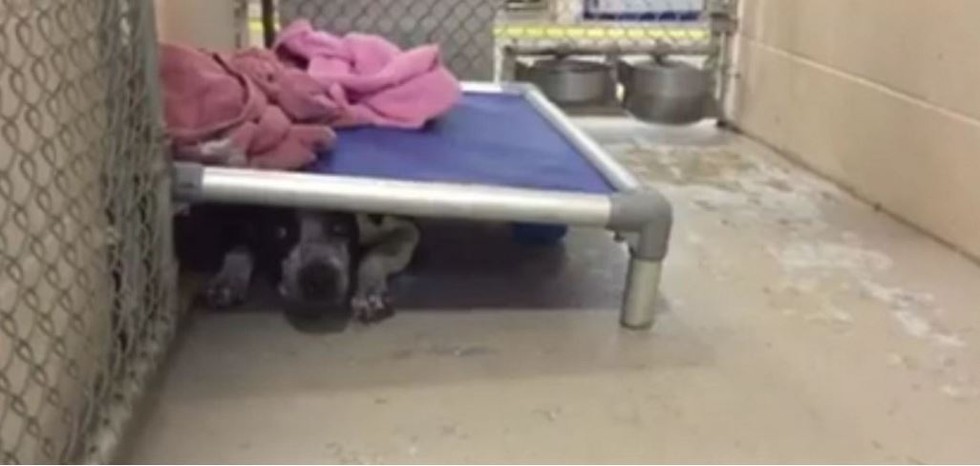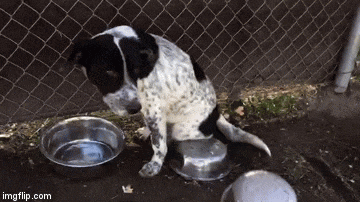It's a dismal reality that dogs who enter shelters must also eventually leave those same shelters.
Whether that's through adoption or, sadly, otherwise.
Space is space, right? There's only so much of it to go around.
Why then, one wonders, do we see dogs being put down at shelters where kennels stand empty?
It's an emotional question that rings out again and again on social media. Why kill dogs when kennels stand empty?
Well, that may be because the answer is more complex than simply space.
For one thing, a dog may be in such an extreme state of medical distress, euthanasia is deemed the most humane option.
"If they are doing it it's probably because there's either something medically or behaviorally wrong," Randall Brown, chief field supervisor at Multnomah County Animal Services in Oregon, tells The Dodo.
Dogs in ailing health, whose days are likely only to get darker, fall into that category. Same goes for dogs who have been deemed dangerous to others by shelter staff.
"They can only put so many resources into one animal," Brown says.
And there's the rub. Space is just one resource a shelter relies upon to care for dogs. There's also staff and volunteers — two of the most underrated factors in prolonging a shelter dog's life — and funds, which are critical for obedience training and enrichment programs designed to make animals more adoptable. And less of a candidate for euthanasia.
Ironically, a dog who spends too long at a shelter can also develop behaviors that make her more likely to be put down. A veteran in the shelter industry who didn't wish to be identified for this story describes a condition known as "kennel craziness".
"It's a really horrible thing to witness," she tells The Dodo. "The animal's personality drastically changes. They may become aggressive or completely checked out, and many of them begin to circle their kennels endlessly or chew their tails. At that point, the quality of life of the animal has to be considered."
At penny-pinched county shelters, the question looms especially large: How much time and energy can be spent on one dog?
"If a dog that is pet-aggressive takes three months to find a home and an overall well-tempered dog takes two weeks, you could save six dogs in the time you had that pet aggressive animal in a kennel," the shelter staffer explains. "That's not to say that animals are just numbers in a shelter. They aren't. Shelter workers take each euthanasia decision very seriously and it's something that is emotional and very challenging. But in the end, the goal of most shelters is to save as many animals as they possible can."
At the other end of the spectrum, MSPCA-Angell, a privately funded shelter system in Massachusetts, has managed to dramatically reduce its kill rate to the point where it's almost negligible.
"If a shelter can garner the resources," Terri Bright, the organization's director of behavior services, tells The Dodo, "if they have good behaviorists, if they have good volunteers, then they can help more dogs to hang in there until they get adopted."
In the last seven years, for example, the organization has increased its adoption rates for bigger dogs from 77 percent to 92 percent.
That's a startling success considering the organization runs an open shelter.
"We take in every single dog someone gives us," Bright says. "They might bring us a dog who's 15 years old and literally on the last days of life. They might bring us a dog who has bitten someone in their family. We'll take both of those dogs because we don't turn any dog away."
The longest stretch a dog has spent at MSPCA-Angell?
305 days.
That dog didn't develop symptoms of prolonged shelter life, and was eventually adopted.
"When she left here," Bright recalls, "she was a better dog than when she came in. She had been to two or three obedience classes. She knew lots of great behaviors."
"For dogs who wind up taking a long time to get adopted, you just have to work harder," she says. "Give more enrichment. More training. More walks. More work. That's how you get them saved."
But Bright knows some dogs, however rarely it may happen, must be put down.
Space isn't the most crucial consideration.
"Is it humane to keep that dog in a shelter forever when you know no one is looking to adopt that dog?"
Maybe that's where we come in. Consider volunteering at your local shelter. You can also save a dog's life by adopting from a shelter.
Whether that's through adoption or, sadly, otherwise.
Space is space, right? There's only so much of it to go around.
 |
| MINDA HARRIS |
Why then, one wonders, do we see dogs being put down at shelters where kennels stand empty?
It's an emotional question that rings out again and again on social media. Why kill dogs when kennels stand empty?
Well, that may be because the answer is more complex than simply space.
For one thing, a dog may be in such an extreme state of medical distress, euthanasia is deemed the most humane option.
"If they are doing it it's probably because there's either something medically or behaviorally wrong," Randall Brown, chief field supervisor at Multnomah County Animal Services in Oregon, tells The Dodo.
Dogs in ailing health, whose days are likely only to get darker, fall into that category. Same goes for dogs who have been deemed dangerous to others by shelter staff.
"They can only put so many resources into one animal," Brown says.
And there's the rub. Space is just one resource a shelter relies upon to care for dogs. There's also staff and volunteers — two of the most underrated factors in prolonging a shelter dog's life — and funds, which are critical for obedience training and enrichment programs designed to make animals more adoptable. And less of a candidate for euthanasia.
 |
| FRIENDS OF COLLIER DOMESTIC ANIMAL SERVICE |
"It's a really horrible thing to witness," she tells The Dodo. "The animal's personality drastically changes. They may become aggressive or completely checked out, and many of them begin to circle their kennels endlessly or chew their tails. At that point, the quality of life of the animal has to be considered."
At penny-pinched county shelters, the question looms especially large: How much time and energy can be spent on one dog?
"If a dog that is pet-aggressive takes three months to find a home and an overall well-tempered dog takes two weeks, you could save six dogs in the time you had that pet aggressive animal in a kennel," the shelter staffer explains. "That's not to say that animals are just numbers in a shelter. They aren't. Shelter workers take each euthanasia decision very seriously and it's something that is emotional and very challenging. But in the end, the goal of most shelters is to save as many animals as they possible can."
At the other end of the spectrum, MSPCA-Angell, a privately funded shelter system in Massachusetts, has managed to dramatically reduce its kill rate to the point where it's almost negligible.
 |
| AMY KLEIN |
In the last seven years, for example, the organization has increased its adoption rates for bigger dogs from 77 percent to 92 percent.
That's a startling success considering the organization runs an open shelter.
"We take in every single dog someone gives us," Bright says. "They might bring us a dog who's 15 years old and literally on the last days of life. They might bring us a dog who has bitten someone in their family. We'll take both of those dogs because we don't turn any dog away."
The longest stretch a dog has spent at MSPCA-Angell?
305 days.
That dog didn't develop symptoms of prolonged shelter life, and was eventually adopted.
"When she left here," Bright recalls, "she was a better dog than when she came in. She had been to two or three obedience classes. She knew lots of great behaviors."
But Bright knows some dogs, however rarely it may happen, must be put down.
Space isn't the most crucial consideration.
"Is it humane to keep that dog in a shelter forever when you know no one is looking to adopt that dog?"
Maybe that's where we come in. Consider volunteering at your local shelter. You can also save a dog's life by adopting from a shelter.